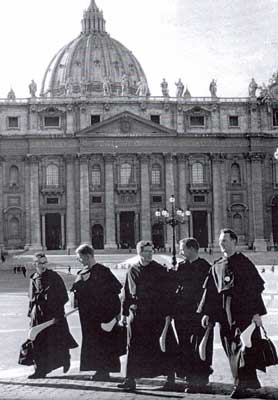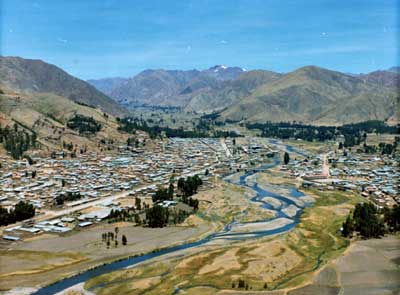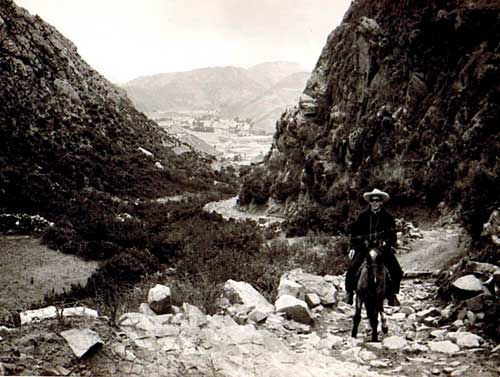|
Growing up
in Kilbeggan, County Westmeath, my only early memory in
connection with South America was hearing that a relative of
our neighbours had an aunt, a nun, who had gone from Westmeath
to a convent in Argentina many years previously. I was also
told that there were a number of other people from Westmeath,
Longford and Wexford who had migrated to Argentina. It is only
in recent times that I have read about a Kilbeggan man named
Duffy who also emigrated to Argentina many years ago. But my
story relates to the Andean country of Peru.
A
chance meeting in Rome
|

Frank
O'Hara, Desmond Kelleher, Ronan Lennon, Paul Graham,
Michael Hender and hurlies in
Rome, 1962 |
I first
heard mention of Peru in Rome in 1962. I was studying theology
at the Carmelite International Theologate within a stone's
throw of St. Peter's Square. The Vatican II Council convened
by Pope John XXIII had brought all the bishops to Rome. Among
them was a Carmelite bishop, Nevin Hayes, a native of Chicago
and Bishop of the Prelature of Sicuani of the Department of
Cuzco in Peru. He spoke to us as a student body and showed us
slides of Sicuani. I was impressed, but did not for a moment
consider the possibility of going there as a missionary
priest. Bishop Hayes belonged to the Chicago Province of
Carmelites, whereas I belonged to the Irish Province whose
only foreign mission at that time was Rhodesia, present-day
Zimbabwe.
I was
ordained in July 1963 and returned to Ireland to my first
assignment as a secondary school teacher at Terenure College
in Dublin. I subsequently discovered that Bishop Hayes had
spoken to the Irish Carmelite Provincial requesting help in
his mission work in Sicuani. The Provincial then sent out a
letter to all the Carmelite houses in Ireland inviting members
to volunteer for work in Sicuani, Peru. I jumped at the chance
to work in Peru, together with six other Carmelite priests.
For some reason I was more attracted to South America than to
Africa. Then one day the Provincial called me aside and told
me he would allow me to work in Sicuani. I had assumed that
two of us would go, but the Carmelites in Zimbabwe were
pleading for more men. The basis on which he allowed me to go
was flexible: he said, 'Des, why don't you go for three years
and see if you like it?' Little did I realise then that I was
to spend thirty years of my life in Peru.
Lima
via New York
I left
Ireland for Peru in October 1964 travelling via New York,
where I visited my uncle Willie and his family in the Bronx.
My father's brother from West Cavan had left his native place
for Cobh, County Cork in 1924, without telling his parents or
siblings. During the Irish War of Independence (1919-1921), he
had been a highly regarded officer. He wrote a letter to his
family from Cobh before boarding the ship for the USA, telling
them in the letter of his decision, asking their forgiveness
for not telling them beforehand as he had feared that it would
break their hearts. Several times in the letter he assured
them that he would only be away for a time and would return.
He never did. Meeting him in the Bronx, I noticed that he had
never lost his Cavan accent. I remember meeting other Irish
people there on that occasion and hearing them express their
anxiety about all the Puerto Ricans who were moving into the
Bronx, which had been until then an Irish stronghold!
I arrived
in Lima on 15 October 1964, the feast day of the Carmelite
Saint Teresa of Avila. In Lima, I was received by the American
Carmelites who had a parish, and a primary and secondary
school in San Antonio, Miraflores, Lima. I immediately
commenced an intensive four-month Spanish course in
Cieneguilla, twenty kilometres outside Lima. I was in a group
of some forty students of Spanish, priests and nuns from
various countries, mostly the USA and Canada. We were all in
the same boat, grappling with a new language with the
frustrations that one experiences early on at not being able
to say all that one wants to say. I remember a Peruvian friend
saying to me one day early on as I tried to speak to him in my
hesitant Spanish, 'Des', he said in Spanish, 'no te preocupes,
poco a poco se va lejos' (don't worry, little by little you'll
go far).
My
destination, Sicuani
Having
completed that course, I set out for Sicuani in the Andes,
travelling by plane to Cuzco on Saint Patrick's Day 1965. I
was now in the 'navel of the world,' as the word 'Cuzco'
signifies in Peru's native language Quechua. I downed a few
Pisco Sours, Peru's typical drink, in honour of Patrick, and
wondered what I was getting myself into as we travelled out
the dusty dirt roads towards Sicuani through narrow
adobe-lined streets, as darkness fell.
Sicuani,
at 3,500 metres above sea level, lies two hours' drive
directly south of Cuzco. In those days as a town it had a
population of 12,000, but as a parish it had a number of
outlying communities called in that area 'parcialidades,'
where most of the population was indigenous. These people were
referred to as 'campesinos', and were more at home speaking
their native language Quechua rather than Spanish. I quickly
saw the need for Quechua for myself so within a year I was off
to Cochabamba in Bolivia for another four-month intensive
course. I found it to be a very different language from
Spanish, though not too difficult as regards pronunciation.
The structure of the language posed problems however, a
language of suffixes that are appended to the root word. With
one long word you can say a lot!
I engaged
in a marvellous variety of work during my first eight years in
Sicuani. I worked in the education of campesino
leaders; I was chaplain in the local prison and hospital and
eventually became more involved in youth work, even helping to
start a Boy Scout group. I was always keen on sport and had
regularly played football in Ireland and soccer in Rome. I got
involved with local soccer teams in Sicuani and played for
various teams over the years in spite of the altitude. The
manager of our team used to say to me before mass on a Sunday,
'hurry up Father, we have a match after mass!'
|

Sicuani, Cuzco,
1965 |
Church of the South Andes
On a
pastoral level I consider myself very fortunate to have worked
for seventeen years in that section of the Peruvian church
referred to as 'la iglesia del Sur Andino', the Church of the
South Andes. Between Dioceses and Prelatures, there were
seven jurisdictions where the bishops, pastoral agents,
priests, nuns and committed lay people all worked together
with great enthusiasm. For years we followed an agreed
pastoral plan for that whole region with a view to
implementing Vatican II and Medellín. It was a very exciting,
challenging, and at times difficult period in the Peruvian
church. Because these Bishops were outspoken in defence of the
poor, and courageous in denouncing injustices and corruption,
they experienced much criticism and constant attacks from both
conservative elements of the Church and right-wing
politicians. For many it was a prophetic part of the Church,
for others who did not want to rock the boat it was looked
upon as dangerous, left wing and too involved in what they
would call 'politics'.
Then
something very tragic happened. Within a few short years, four
of the most conspicuous and courageous bishops of that region
were all killed in violent accidents. They were the bishops of
Cuzco, Ayaviri, Puno and Juli. To this day many people refuse
to believe that their deaths were accidental. The truth is that from
that point on the vibrant prophetic voice of the Church of the
South Andes has been greatly silenced. It is replaced by rigid
structures and pastoral guidelines imposed upon the region by
bishops installed by Rome, most of them from Opus Dei and
Sodalitium Christianae Vitae, the most conservative and reactionary elements in
the Catholic Church.
I
ministered in various parishes in the Prelature of Sicuani
over the seventeen years I spent there. I got more at home
with the Quechua language, understood the people more and
more, particularly their customs and beliefs, loved their
music and dances, their capacity to celebrate life in spite of
harsh conditions and their constant struggle against
adversity. I admired their willingness to share what little
they had. I feel that I grew up there. I did not learn much
theology during my four years in Rome. I did learn theology in
Peru, in the South Andes. |




